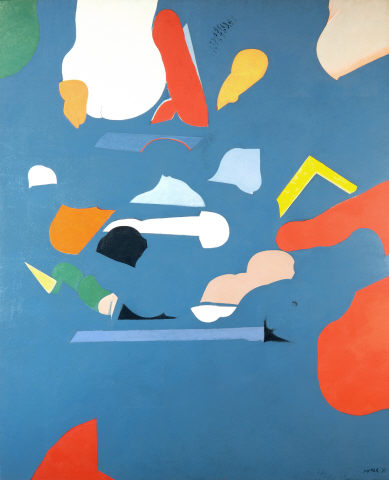
- 1971
- Canvas
- Acrylic paint
- Inv. 83P772
Júlio Pomar
Le Bain Turc, d’aprés Ingres
This work by Júlio Pomar is one of several paintings inspired by Ingres’s painting Le Bain Turc (1862), a series which the Portuguese painter began in 1968, and, interpolating it with other themes, continued until 1973. Pomar had already painted other works that explicitly referenced the work of other artists (Goya and Uccello) and his work around Ingres took place at the same time as he was making other pictorial comments on van Eyck, Courbet, and, shortly afterwards, Chardin. The work that he produced during these years also reveals that he was exploring the potential of acrylic, which several painters began using in the mid-1960s, and which allowed him to combine intense, opaque colours in blocks, eliminating gradations and transparency. The language of acrylic therefore lends the works of this period a graphic assertiveness, in contrast to the way that subjects were fragmented in free brush strokes in works created immediately beforehand and in some subsequent paintings.
In the series Le Bain Turc (The Turkish Bath), Pomar appropriates some elements of Ingres’s work, varying the choice in each piece in the series, imbuing them with, or depriving them of, formal and erotic significance. In the work currently held by the CAM collection, which is rectangular in shape (Ingres’s canvas was also initially rectangular, only to be subsequently modified and cut by the French painter into a circular shape), it is difficult to recognise the Ingresque motifs that emerge, scattered, disassociated, modified, and dislocated in relation to their position in the original. In fact, they are stylised to the point that only an enunciation of the elements painted by Ingres remains. The female figures have been arranged as negative images: they are immersed in the blue and are vaguely referenced by the contrast established between them and the other elements that correspond to summaries of the inanimate bodies, that is, the architectural elements, the musical instrument, the rugs, the turbans, and the objects (which sometimes assume a phallic shape). Ingres’s crowd of bodies, which prevents the gaze from settling on any one point, is here made almost totally uniform, tamed, and rendered in a single colour. However, the black pubis and navel of a supine figure, whose concubinary pose can be recognised from the original Le Bain Turc, stand out. The Le Bain Turc series does not only reference Ingres: in this group of works (and others), Pomar also invokes Matisse’s cut-paper collages. Representing more than a mere quotation, this technique is transposed to the painting: the cut-out and collage are fictionalised with paint. The curious connection established between the two French painters, between the primacy of drawing and its rejection, results in the affirmation not only of the efficacy of the outline in Ingres’s work, but also of those elements which, despite being almost invisible in the 1862-version of Le Bain Turc, consolidate and balance the composition. In highlighting them, Pomar frees them.
This painting joins the tradition by which modern painters interpret, appropriate, recreate, and pay homage to the works of the masters. It also justifies the participation of the Portuguese painter in the 1971 exhibition Le Bain Turc d‘Ingres, held at the Louvre, where works from this series appeared alongside works by such names as Picasso, Man Ray, and Rauschenberg.
Mariana Pinto dos Santos
May 2010
| Type | Value | Unit | Section |
| Width | 130 | cm | |
| Height | 161 | cm |
| Type | signature |
| Type | date |
| Type | Acquisition |
| 4º Prémio Amadeo de Souza-Cardoso: Júlio Pomar |
| Museu Municipal Amadeo de Souza-Cardoso |
| Curator: Museu Municipal Amadeo de Souza-Cardoso |
| 13 de Setembro de 2003 a 2 de Novembro de 2003 Museu Municipal Amadeo de Souza-Cardoso |
| Exposição realizada no âmbito da atribuição do Prémio Amadeo de Souza-Cardoso ao Mestre Júlio Pomar. |